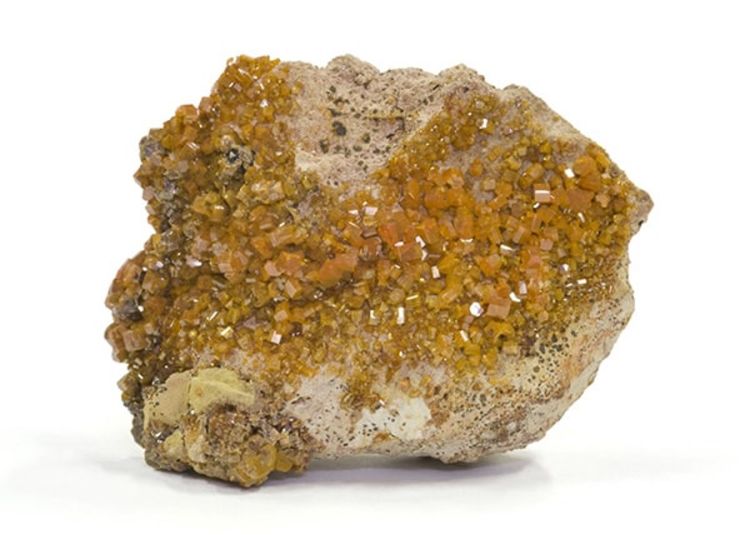BACKGROUND
Ingredient Type: Mineral
Also Known As: Chemical element with the symbol V and an atomic number of 23 (1).

Vanadium is a trace mineral found deposited in the earth. It is believed to promote a healthy balance of sugar and insulin in the blood and it may regulate certain proteins in the body (1).
Vanadium is a chemical element with the symbol V and an atomic number of 23. It is a soft, silvery gray, ductile transition metal, which means that it transforms under stress and is located in the “d-block” of the periodic table (all groups in the d-block are metals). Vanadium forms an oxide layer to stabilize the metal against oxidation. Metallic vanadium does not exist in nature but is found in approximately 65 minerals. Vanadium has a very limited role in biology and is more important in ocean environments than on land. Vanadium is used by some life forms, particular those living in the ocean, as an enzyme activator, such as the vanadium bromoperoxidase of some ocean algae (1). Vanadium may be a micronutrient in mammals, including humans, but its precise role in this regard is unknown (2).
Metallopharmaceutics, an area that includes the use of vanadium for the treatment of diabetes, has been used in various forms over thousands of years (2). The use of vanadium in diabetic patients was first introduced over 100 years ago (3,4,5). However, the use of orally active vanadium complexes, such as vanadyl (+4 oxidation state of oxovanadium), to normalize hyperglycemia in the streptozocin (STZ)-induced type 1 diabetic rats was not first presented until the 1990s (6).
The history of vanadium as a pharmacological tool in cell death signaling has been reviewed (7). Additional details are currently lacking.
TRADITIONAL USES
Vanadium is used in health supplements today to help balance blood sugar.
Orally, vanadium is used for diabetes, hypoglycemia, hyperlipidemia, heart disease, edema, improving athletic performance in weight training, and preventing cancer. Vanadium is also used for treating tuberculosis, diabetes, syphilis, and a form of microcytic anemia (chlorosis) (3).
WHAT DOES SCIENCE TELL US?
Vanadium Possibly Reduces Blood Glucose:
There is some evidence that high oral doses of vanadyl sulfate (100 mg daily, 31 mg elemental vanadium), can improve hepatic and peripheral insulin sensitivity in patients with type 2 diabetes and possibly reduce blood glucose levels (9,10,11,12,13); however, prolonged use of these high doses might not be safe (14). It’s not known if lower doses have the same benefit. Clinical studies of vanadium have included a total of fewer than 40 patients. Until more is known, caution should be taken and a physician should be consulted before using vanadium for type 2 diabetes (14).
SAFETY
Considered safe when used orally and appropriately. Vanadium is safe when taken in amounts below the tolerable upper intake level (UL) of 1.8 mg per day (8).
REFERENCES
- Opinion of the Scientific Panel on Dietetic Products, Nutrition and Allergies on a request from the Commission related to the Tolerable Upper Intake Level of Vanadium. The EFSA Journal 2004;33:1-22.
- Sakurai, H., Yoshikawa, Y., and Yasui, H. Current state for the development of metallopharmaceutics and anti-diabetic metal complexes. Chem Soc Rev 2008;37(11):2383-2392
- Thompson, K. H. and Orvig, C. Vanadium in diabetes: 100 years from Phase 0 to Phase I. J Inorg.Biochem 2006;100(12):1925-1935.
- Sakurai, H. A new concept: the use of vanadium complexes in the treatment of diabetes mellitus. Chem Rec. 2002;2(4):237-248
- Shechter, Y. and Shisheva, A. Vanadium salts and the future treatment of diabetes. Endeavour 1993;17(1):27-31
- Sakurai, H. [Treatment of diabetes in experimental animals by metallocomplexes]. Yakugaku Zasshi 2008;128(3):317-322
- Morinville, A., Maysinger, D., and Shaver, A. From Vanadis to Atropos: vanadium compounds as pharmacological tools in cell death signalling. Trends Pharmacol Sci 1998;19(11):452-460
- Food and Nutrition Board, Institute of Medicine. Dietary Reference Intakes for Vitamin A, Vitamin K, Arsenic, Boron, Chromium, Copper, Iodine, Iron, Manganese, Molybdenum, Nickel, Silicon, Vanadium, and Zinc. Washington, DC: National Academy Press, 2002. Available at: www.nap.edu/books/0309072794/html/.
- Halberstam M, Cohen N, Shlimovich P, et al. Oral vanadyl sulfate improves insulin sensitivity in NIDDM but not in obese nondiabetic subjects. Diabetes 1996;45:659-66.
- Cohen N, Halberstam M, Shlimovich P, et al. Oral vanadyl sulfate improves hepatic and peripheral insulin sensitivity in patients with non-insulin-dependent diabetes mellitus. J Clin Invest 1995;95:2501-9
- Boden G, Chen X, Ruiz J, et al. Effects of vanadyl sulfate on carbohydrate and lipid metabolism in patients with non-insulin-dependent diabetes mellitus. Metabolism 1996;45:1130-5
- Goldfine AB, Simonson DC, Folli F, et al. Metabolic effects of sodium metavanadate in humans with insulin-dependent and noninsulin-dependent diabetes mellitus in vivo and in vitro studies. J Clin Endocrinol Metab 1995;80:3311-20.
- Cusi K, Cukier S, DeFronzo RA, et al. Vanadyl sulfate improves hepatic and muscle insulin sensitivity in type 2 diabetes. J Clin Endocrinol Metab 2001;86:1410-7
- Food and Nutrition Board, Institute of Medicine. Dietary Reference Intakes for Vitamin A, Vitamin K, Arsenic, Boron, Chromium, Copper, Iodine, Iron, Manganese, Molybdenum, Nickel, Silicon, Vanadium, and Zinc. Washington, DC: National Academy Press, 2002. Available at: www.nap.edu/books/0309072794/html/.
- https://naturalmedicines.therapeuticresearch.com
See the Examine.com entry for vanadium, the RXList entry for vanadium, the Michigan Medicine Health Library entry for vanadium, or the WebMD entry for vanadium for more information.









